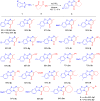Reagent-controlled regiodivergent intermolecular cyclization of 2-aminobenzothiazoles with β-ketoesters and β-ketoamides
- PMID: 29564009
- PMCID: PMC5753174
- DOI: 10.3762/bjoc.13.270
Reagent-controlled regiodivergent intermolecular cyclization of 2-aminobenzothiazoles with β-ketoesters and β-ketoamides
Abstract
Two regiodivergent approaches to intermolecular cyclization of 2-aminobenzothiazoles with β-ketoesters and amides have been developed, controlled by the reagents employed. With the Brønsted base KOt-Bu and CBrCl3 as radical initiator, benzo[d]imidazo[2,1-b]thiazoles are synthesized via attack at the α-carbon and keto carbon of the β-ketoester moiety. In contrast, switching to the Lewis acid catalyst, In(OTf)3, results in the regioselective nucleophilic attack at both carbonyl groups forming benzo[4,5]thiazolo[3,2-a]pyrimidin-4-ones instead.
Keywords: cyclization; fused-ring systems; indium; radical; regiodivergent.
Figures






Similar articles
-
Regioselective oxidative cross-coupling of benzo[d]imidazo[2,1-b]thiazoles with styrenes: a novel route to C3-dicarbonylation.Org Biomol Chem. 2017 Sep 20;15(36):7696-7704. doi: 10.1039/c7ob01778b. Org Biomol Chem. 2017. PMID: 28872171
-
Transition-metal-free synthesis of imidazo[2,1-b]thiazoles and thiazolo[3,2-a]benzimidazoles via an S-propargylation/5-exo-dig cyclization/isomerization sequence using propargyl tosylates as substrates.J Org Chem. 2014 Nov 7;79(21):10367-77. doi: 10.1021/jo501980w. Epub 2014 Oct 16. J Org Chem. 2014. PMID: 25320838
-
Ni-Catalyzed Ligand-Controlled Regiodivergent Reductive Dicarbofunctionalization of Alkenes.J Am Chem Soc. 2021 Jul 14;143(27):10282-10291. doi: 10.1021/jacs.1c03827. Epub 2021 Jun 23. J Am Chem Soc. 2021. PMID: 34162201
-
Synthesis of 1,3,5-Triazepines and Benzo[f][1,3,5]triazepines and Their Biological Activity: Recent Advances and New Approaches.Molecules. 2024 Jan 29;29(3):632. doi: 10.3390/molecules29030632. Molecules. 2024. PMID: 38338376 Free PMC article. Review.
-
[Development of radical reactions in water aimed at environmentally benign synthetic reactions].Yakugaku Zasshi. 2004 Jun;124(6):311-9. doi: 10.1248/yakushi.124.311. Yakugaku Zasshi. 2004. PMID: 15170066 Review. Japanese.
Cited by
-
Synthesis of Polycyclic Fused Indoline Scaffolds through a Substrate-Guided Reactivity Switch.J Org Chem. 2020 Sep 4;85(17):11409-11425. doi: 10.1021/acs.joc.0c01489. Epub 2020 Aug 21. J Org Chem. 2020. PMID: 32786612 Free PMC article.
-
On water catalyst-free synthesis of benzo[d]imidazo[2,1-b] thiazoles and novel N-alkylated 2-aminobenzo[d]oxazoles under microwave irradiation.RSC Adv. 2020 Jan 3;10(2):770-778. doi: 10.1039/c9ra08929b. eCollection 2020 Jan 2. RSC Adv. 2020. PMID: 35494448 Free PMC article.
References
LinkOut - more resources
Full Text Sources
Other Literature Sources
